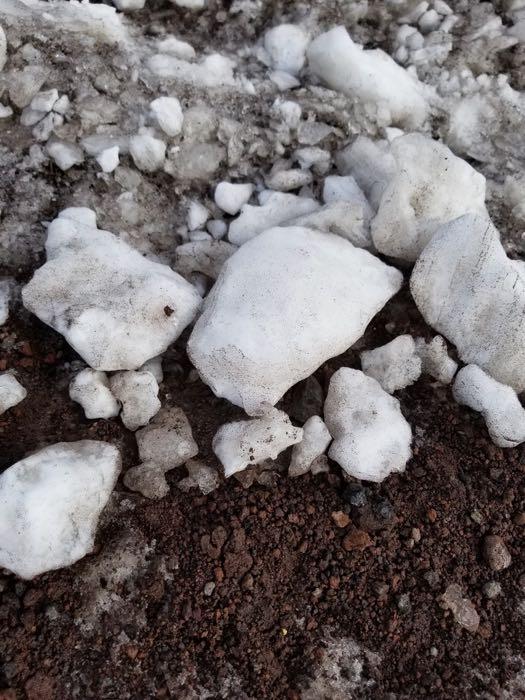Albedo
It's 25 degrees F right now, but there are puddles of liquid water turning the volcanic dirt to mud. "Mudd-Murdo" has begun.
Just how is it possible that it's 25 degrees- water freezes at 32- and yet there are puddles?
Is the thermometer lying?


Look carefully at the difference. They are both in direct sunlight.
What is different?

You can try this out at home too. On a nice sunny afternoon, set out a white sheet of paper with a thermometer on it. Do the same for a black sheet. Let it set for ten minutes. The temperature of each will be very different. Which one will be the hottest?
The ability of a surface to reflect heat is called albedo. Surfaces with a high albedo reflect a lot of the sun's radiation. Surfaces with a low albedo absorb most of the radiation, so they get hot faster. The number is kind of like a percentage of reflection- 0 being total absorption(black), 1.0 being total reflection- pure white. It is a unitless measure indicating the "Whiteness" of a surface. For example, sea water has an albedo of around 0.06, while snow is a whooping 0.5 to 0.7. It reflects up to ten times the solar radiation.


What about if you tried this same experiment in the early morning or late evening? Would you have the same results? Probably not. The angle of the sun at midday is much more direct that in the morning or evening. You should not have as much of a difference between surfaces due to albedo.
Why is Antarctica so Cold?
The angle of the sun is also part of an answer to a question I was asked on a previous journal. A student asked why Antarctica is so cold. It has to do with the 23.5 degree tilt of the Earth. It makes the sun's rays hit at an angel. This spreads out the radiation energy over a larger area. It decreases the amount of heat at a given spot.
Another reason that it is so cold is because of the elevation. As you know, our atmosphere gets colder the higher you go up in the mountains. Antarctica is the highest continent in elevation, averaging 7,500 feet. So, it is also cold because of the elevation.

Antarctica is land surrounded by ocean. This land is covered in a giant sheet of ice. That ice reflects more sun-(albedo) than the surrounding ocean. It does not absorb heat like in the Arctic where it is ocean surrounded by land. This much land also means it is drier. The low moisture makes the dew point very low, allowing the temperature to drop even further. Dry air changes temperature more rapidly that humid air.

Shout Out


Tomorrow
Tomorrow is a lab day. Dr. Todgham will likely spend the day writing. There is a lot of writing required in order to explain all of her science. She writes presentations, as well as publishes papers on her research. Milica will be running mitochondria analysis, and I might be helping Andrew run his behavior experiments. My main goal is to show you what they are doing...while not getting in their way or slowing them down!
Stay Cool,


Comments